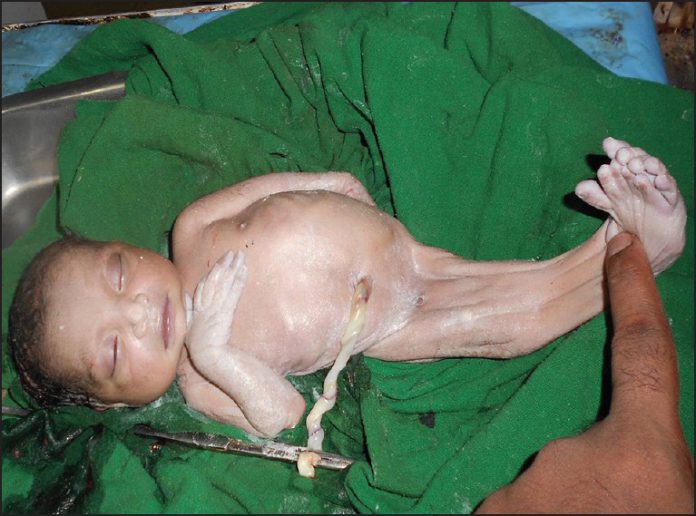A full-term, 2.5 kg baby was born vaginally at 39+5d gestational age to a 27-year-old woman. The baby was born with multiple congenital anomalies which remained undetected during the antenatal period due to lack of prenatal care. كيفية لعب البوكر The baby exhibited features of Potter’s syndrome (hypertelorism, prominent epicanthal folds, low-set ears, slit-like mouth, etc.). Alongside baby had a few other developmental abnormalities like hypoplastic thumbs, absent genitals, narrow chest and most prominently fused lower limbs with one foot and five toes only (Sirenomelia).
The mother had no known congenital or genetic abnormality. She had a positive history of tobacco smoking before and even during pregnancy. Her antenatal, intrapartum and postpartum periods remain uneventful.
Unfortunately, the baby was born with poor APGAR scores of 3 and 0 at 1 minute and 5 minutes, respectively. Despite adequate resuscitative measures, the baby succumbed to death within the first 30 minutes of life. The parents declined the autopsy request. الرهانات
Sirenomelia, also known as mermaid syndrome, is an exceptionally rare but fatal congenital developmental disorder. It has features of severe caudal regression syndrome characterized by anomalies of lumbosacral spine, pelvis and the lower limbs. رهان كرة القدم It is also associated with partial or complete agenesis of the kidneys, abnormalities of the genitourinary, gastrointestinal, limb abnormalities, absent phalanges.
Both environmental and genetic factors play a role. Few hypotheses suggest that inadequate blood, nutrient supply and defective blastogenesis interfere with the notochord formation, resulting in abnormal development of caudal structures. Though the exact causes of sirenomelia are still unknown. Environmental factors include maternal tobacco smoking, diabetes mellitus, retinoic acid intake, metallic exposure.
Short crown-rump length detected on the first-trimester
ultrasound may be suggestive of sirenomelia. It can be conveniently diagnosed
during the second trimester by prenatal ultrasound along with detection of
associated congenital defects. If no antenatal ultrasound has been performed,
then the diagnosis is evident at birth. Ultrasonography and Infantogram can
detect internal and bony abnormalities, respectively.
When sirenomelia is associated with fatal anomalies like bilateral renal agenesis, then the survival is next to impossible due to lethal oligohydramnios and resulting lung hypoplasia. In cases where non-lethal defects are present, there is still hope. This too requires multidisciplinary efforts by a team of paediatricians, pediatric surgeons, nephrologists, cardiologists, orthopedists, etc. Fused mermaid legs can be surgically separated after systematically and progressively expanding the skin pre-operatively, using balloon or saline expanders. This excess skin is required to cover the newly separated legs. Not forgetting to mention here that, rarely newborns survive enough to see the operating room due to the lethality of this syndrome.
References:
Saxena, R., & Puri, A. (2015). Sirenomelia or mermaid syndrome. The Indian journal of medical research, 141(4), 495. https://doi.org/10.4103/0971-5916.159323
Samal, S. K., & Rathod, S. (2015). Sirenomelia: The mermaid syndrome: Report of two cases. Journal of natural science, biology, and medicine, 6(1), 264–266. https://doi.org/10.4103/0976-9668.149227




